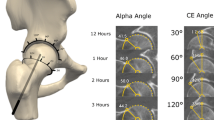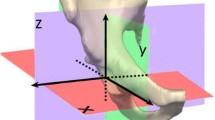Abstract
Background
Valgus hips with increased antetorsion present with lack of external rotation and posterior hip pain that is aggravated with hip extension and external rotation. This may be the result of posterior femoroacetabular impingement (FAI).
Questions/purposes
We asked whether (1) the range of motion (ROM); (2) the location of anterior and posterior bony collision zones; and (3) the prevalence of extraarticular impingement differ between valgus hips with increased antetorsion compared with normal hips and hips with idiopathic FAI.
Methods
Surface models based on CT scan reconstructions of 13 valgus hips with increased antetorsion, 22 hips with FAI, and 27 normal hips were included. Validated three-dimensional collision detection software was used to quantify the simulated hip ROM and the location of impingement on the acetabular and the femoral sides.
Results
Hips with coxa valga and antetorsion showed decreased extension, external rotation, and adduction, whereas internal rotation in 90° of flexion was increased. Impingement zones were more anteroinferior on the femur and posteroinferior on the acetabular (pelvic) side; and the zones were more frequently extraarticular, posterior, or to a lesser degree anterior against the inferior iliac spine. We found a higher prevalence of extraarticular impingement for valgus hips with increased antetorsion.
Conclusions
Valgus hips with increased antetorsion predispose to posterior extraarticular FAI and to a lesser degree anteroinferior spine impingement.
Level of Evidence
Level II, prognostic study. See Guidelines for Authors for a complete description of levels of evidence.



Similar content being viewed by others
References
Audenaert EA, Peeters I, Vigneron L, Baelde N, Pattyn C. Hip morphological characteristics and range of internal rotation in femoroacetabular impingement. Am J Sports Med. 2012;40:1329–1336.
Beck M, Kalhor M, Leunig M, Ganz R. Hip morphology influences the pattern of damage to the acetabular cartilage: femoroacetabular impingement as a cause of early osteoarthritis of the hip. J Bone Joint Surg Br. 2005;87:1012–1018.
Bombelli R. [Biomechanical significance of coxa valga in relation to dysplasia of the acetabulum] [in German]. Z Orthop Ihre Grenzgeb. 1985;123:452–455.
Botser IB, Ozoude GC, Martin DE, Siddigi AJ, Kuppuswami S, Domb BG. Femoral anteversion in the hip: comparison of measurement by computed tomography, magnetic resonance imaging, and physical examination. Arthroscopy. 2012;28:619–627.
Clohisy JC, Nunley RM, Carlisle JC, Schoenecker PL. Incidence and characteristics of femoral deformities in the dysplastic hips. Clin Orthop Relat Res. 2009;467:128–134.
Haverkamp D, Marti RK. Bilateral varus osteotomies in hip deformities: are early interventions superior? A long-term follow-up. Int Orthop. 2007;31:185–191.
Kubiak-Langer M, Tannast M, Murphy SB, Siebenrock KA, Langlotz F. Range of motion in anterior femoroacetabular impingement. Clin Orthop Relat Res. 2007;458:117–124.
Kummer B. [Clinical significance of coxa valga] [in German]. Z Orthop Ihre Grenzgeb. 1985;123:443–452.
MacDonald S, Garbuz D, Ganz R. Clinical evaluation of the symptomatic young adult hip. Semin Arthroplasty. 1997;8:3–9.
Mahaisavariya B, Sitthiseripratip K, Tongdee T, Bohez EL, Vander Sloten J, Oris P. Morphological study of the proximal femur: a new method of geometrical assessment using 3-dimensional reverse engineering. Med Eng Phys. 2002;24:617–622.
Murphy SB, Ganz R, Muller ME. The prognosis in untreated dysplasia of the hip. A study of radiographic factors that predict the outcome. J Bone Joint Surg Am. 1995;77:985–989.
Murphy SB, Simon SR, Kijewski PK, Wilkinson RH, Griscom NT. Femoral anteversion. J Bone Joint Surg Am. 1987;69:1169–1176.
Notzli HP, Wyss TF, Stoecklin CH, Schmid MR, Treiber K, Hodler J. The contour of the femoral head-neck junction as a predictor for the risk of anterior impingement. J Bone Joint Surg Br. 2002;84:556–560.
Pauwels F. Biomechanics of the Normal and Diseased Hip. Theoretical Foundation, Technique and Results of Treatment. New York, NY, USA: Springer; 1976.
Puls M, Ecker TM, Steppacher SD, Tannast M, Siebenrock KA, Kowal JH. Automated detection of the osseous acetabular rim using three-dimensional models of the pelvis. Comput Biol Med. 2011;41:285–291.
Puls M, Ecker TM, Tannast M, Steppacher SD, Siebenrock KA, Kowal JH. The equidistant method—a novel hip joint simulation algorithm for detection of femoroacetabular impingement. Comput Aided Surg. 2010;15:75–82.
Reynolds D, Lucas J, Klaue K. Retroversion of the acetabulum. A cause of hip pain. J Bone Joint Surg Br. 1999;81:281–288.
Robin J, Graham HK, Selber P, Dobson F, Smith K, Baker R. Proximal femoral geometry in cerebral palsy: a population-based cross-sectional study. J Pediatr Orthop. 2006:26;536–541.
Steppacher SD, Tannast M, Werlen S, Siebenrock KA. Femoral morphology differs between deficient and excessive acetabular coverage. Clin Orthop Relat Res. 2008;466:782–790.
Stulberg SD, Cooperman DR, Wallensten R. The natural history of Legg-Calve-Perthes disease. J Bone Joint Surg Am. 1981;63:1095–1108.
Tannast M, Goricki D, Beck M, Murphy SB, Siebenrock KA. Hip damage occurs at the zone of femoroacetabular impingement. Clin Orthop Relat Res. 2008;466:273–280.
Tannast M, Hanke M, Ecker TM, Murphy SB, Albers CE, Puls M. LCPD: reduced range of motion resulting from extra- and intraarticular impingement. Clin Orthop Relat Res. 2012;470:2431–2440.
Tannast M, Kubiak-Langer M, Langlotz F, Puls M, Murphy SB, Siebenrock KA. Noninvasive three-dimensional assessment of femoroacetabular impingement. J Orthop Res. 2007;25:122–131.
Tannast M, Langlotz U, Siebenrock KA, Wiese M, Bernsmann K, Langlotz F. Anatomic referencing of cup orientation in total hip arthroplasty. Clin Orthop Relat Res. 2005;436:144–150.
Tannast M, Siebenrock KA, Anderson SE. Femoroacetabular impingement: radiographic diagnosis—what the radiologist should know. AJR Am J Roentgenol. 2007;188:1540–1552.
Tönnis D. General Radiography of the Hip Joint. Berlin, Heidelberg, Germany: Springer; 1987:100–142.
Tönnis D, Heinecke A. Acetabular and femoral anteversion: relationship with osteoarthritis of the hip. J Bone Joint Surg Am. 1999;81:1747–1770.
Tubby AH. Coxa valga (Collum valgum). Proc R Soc Med. 1908;1:107.
Zheng G, Tannast M, Anderegg C, Siebenrock KA, Langlotz F. Hip2Norm: an object-oriented cross-platform program for 3D analysis of hip joint morphology using 2D pelvic radiographs. Comput Methods Programs Biomed. 2007;87:36–45.
Author information
Authors and Affiliations
Corresponding author
Additional information
Each author certifies that he or she, or a member of their immediate family, has no commercial associations (eg, consultancies, stock ownership, equity interest, patent/licensing arrangements, etc) that might pose a conflict of interest in connection with the submitted article.
All ICMJE Conflict of Interest Forms for authors and Clinical Orthopaedics and Related Research editors and board members are on file with the publication and can be viewed on request.
Each author certifies that his or her institution approved the human protocol for this investigation, that all investigations were conducted in conformity with ethical principles of research, and that informed consent for participation in the study was obtained.
About this article
Cite this article
Siebenrock, K.A., Steppacher, S.D., Haefeli, P.C. et al. Valgus Hip With High Antetorsion Causes Pain Through Posterior Extraarticular FAI. Clin Orthop Relat Res 471, 3774–3780 (2013). https://doi.org/10.1007/s11999-013-2895-9
Published:
Issue Date:
DOI: https://doi.org/10.1007/s11999-013-2895-9




